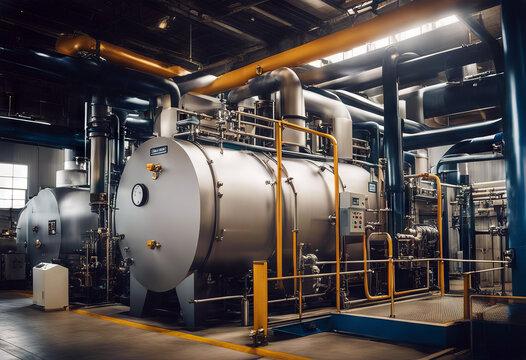Introduction
The Advanced Utility Boilers Market is growing steadily as global power generation systems transition toward higher efficiency, lower emissions, and cleaner combustion technologies. Advanced utility boilers—used primarily in large-scale thermal power plants—leverage cutting-edge engineering to burn coal, biomass, natural gas, and other fuels with greater heat efficiency and lower environmental impact. These modern boilers incorporate supercritical and ultra-supercritical technologies, advanced combustion controls, and state-of-the-art materials to support improved steam generation and enhanced power plant performance. As energy demand rises and countries modernize aging infrastructure, the need for high-efficiency utility boilers is increasing. Additionally, stringent emission regulations and a global focus on decarbonization are influencing the development of next-generation boiler systems.
Market Drivers
The primary driver of the Advanced Utility Boilers Market is the global push for more efficient and environment-friendly power generation systems. Supercritical and ultra-supercritical boilers offer significantly higher efficiency compared to subcritical units, reducing fuel consumption and lowering CO₂ emissions. Many countries, particularly in Asia-Pacific, are upgrading or replacing aging coal-fired power plants with advanced boiler technologies to meet rising electricity demand. Growth of industrialization in emerging economies further increases the need for reliable energy, driving adoption of advanced thermal power systems. Additionally, advancements in boiler automation, heat recovery, and combustion optimization are enabling power producers to operate at higher efficiency levels. Government regulations regarding sulfur oxides (SOₓ), nitrogen oxides (NOₓ), and particulate emissions also push utilities to adopt cleaner and more technologically advanced boilers.
Market Challenges
Despite promising growth, the market faces challenges such as pressure on coal-based power generation, high capital costs, and growing competition from renewable energy. Many countries are reducing their dependence on coal due to climate commitments, which affects investments in coal-fired boiler systems. Advanced boilers require substantial upfront investment, complex engineering, and extensive installation timelines, making them less accessible for smaller utilities. The transition toward natural gas, solar, wind, and hydroelectric power further limits demand for certain boiler technologies. Moreover, strict emission regulations require expensive air pollution control systems to be integrated with boilers, increasing operational and compliance costs. Supply chain delays, skilled labor shortages, and fluctuations in material prices—particularly for high-grade alloys—also pose challenges.
Market Opportunities
The Advanced Utility Boilers Market presents significant opportunities as modern power systems evolve. Upgrading old subcritical boilers with supercritical or ultra-supercritical units provides considerable market potential, especially in Asia-Pacific, the Middle East, and Africa. There is increasing demand for circulating fluidized bed (CFB) boilers and biomass-fired boilers due to their ability to handle low-grade fuels and waste biomass while maintaining efficiency. Hybrid systems that combine fossil fuels with biomass co-firing can help power generators reduce carbon footprints without fully retiring existing infrastructure. Carbon capture-ready boilers are emerging as a major opportunity, enabling power plants to integrate capture technologies in the future. Waste-to-energy boilers also represent a rapidly growing segment as governments adopt circular economy strategies. Digitalization—such as AI-driven boiler monitoring, predictive maintenance, and real-time combustion optimization—enhances performance and reduces operational risks, opening new service-based opportunities.
Regional Insights
Asia-Pacific dominates the Advanced Utility Boilers Market due to large-scale energy demand, expanding industrial activity, and ongoing modernization of aging power plants. China continues to be the largest market for advanced supercritical and ultra-supercritical boiler installations. India is experiencing strong demand due to growing electricity consumption and government-led upgrades to thermal power plants. Southeast Asia—including Indonesia, Vietnam, and the Philippines—is adopting advanced boiler systems as part of their expanding power infrastructure. Europe shows moderate demand, primarily driven by biomass-fired boilers, waste-to-energy systems, and natural gas-based boiler modernization. North America’s demand is stable, with emphasis on gas-fired utility boilers and selective upgrades to meet emissions standards. The Middle East and Africa show increasing interest due to industrialization and grid expansion, particularly in countries like Saudi Arabia, UAE, South Africa, and Egypt.
Future Outlook
The future of the Advanced Utility Boilers Market will be shaped by energy transition strategies, fuel diversification, and technological innovation. Ultra-supercritical and advanced CFB boilers will continue to rise in adoption due to higher efficiency and lower emissions. Integration of digital twins, AI-based optimization, and automation will enhance reliability and reduce downtime. Biomass and waste-to-energy boiler technologies will gain prominence as part of global decarbonization efforts. Hybrid systems that combine renewable energy with advanced utility boilers will support flexible power generation. Carbon capture integration and hydrogen-compatible boilers are expected to redefine the future of thermal power plants. Over the next decade, advanced utility boilers will play a critical role in supporting energy security, grid stability, and sustainable power generation.
Conclusion
The Advanced Utility Boilers Market is evolving as power utilities and industrial facilities seek high-efficiency, low-emission energy solutions. While market growth is influenced by the global shift toward renewable energy, advanced boilers remain essential for reliable base-load power generation, particularly in rapidly developing regions. Innovations in ultra-supercritical technology, biomass co-firing, digital monitoring, and carbon capture readiness are shaping the next generation of boiler systems. Companies that focus on advanced engineering, sustainable fuel integration, and digital optimization will lead the market’s growth trajectory. As global electricity demand continues to rise, advanced utility boilers will remain influential components of modern thermal power infrastructure.

